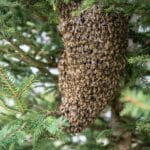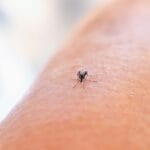Main Points
- Bees are essential for pollination, which is crucial for the production of food and maintaining biodiversity.
- Recognizing different types of bees can help you understand their behavior and roles in the ecosystem.
- Creating bee-friendly habitats and gardens can help support bee populations and biodiversity.
- Safe relocation and natural repellents are effective methods to manage bee encounters without causing them harm.
- Avoiding pesticides and working with local beekeepers are vital for sustainable bee management.
The Bees’ Knees: How to Handle Bees Without Harming Them
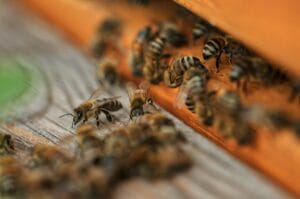
Bees are more than just insects that buzz around; they are crucial to our ecosystem. They play a significant role in pollination, which helps in the production of fruits, vegetables, and nuts. However, dealing with bees, especially when they encroach on our personal spaces, can be a challenge. In this article, I’ll walk you through some practical ways to handle bees without causing them harm.
The Importance of Saving Bees
Preserving bees is crucial for both biodiversity and food security. Bees take on the role of pollinating approximately one-third of the food we consume. If bees were not around, many plants would not be able to reproduce, which would result in a decrease in food production and natural habitats.
Moreover, bees play a vital role in the flourishing of trees, flowers, and other vegetation, which in turn provides nourishment and habitat for a multitude of species. So, when we talk about protecting bees, we’re really talking about protecting the whole web of life.
Recognizing Different Bee Species
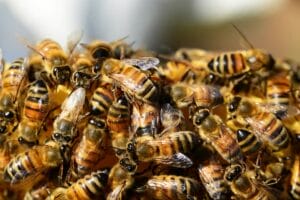
Before you start managing bees, you need to know what type of bees you’re dealing with. Each species has its own behaviors and roles in the ecosystem.
Meet the Bees: Who They Are and What They Do
There are a few key players in the world of bees, each with their own special traits. Understanding these traits can help in effective pest control strategies.
- Honey Bees: These bees are sociable and live in large colonies. They are exceptional pollinators and honey producers.
- Bumblebees: These bees are recognized by their large bodies and loud buzzing sound. They are also sociable and live in smaller colonies. They are efficient pollinators, especially in colder climates.
- Carpenter Bees: These bees are solitary and are known for their habit of burrowing into wood to create nests. While they can cause damage to structures, they are also good pollinators.
- Solitary Bees: This category includes various species such as mason bees and leafcutter bees. They do not live in colonies and are efficient pollinators.
Understanding Bee Behavior
Knowing how bees behave can help in managing them effectively. Bees are generally not aggressive unless they are provoked. They are attracted to flowers and plants because of the nectar and pollen.
Swarming is a natural occurrence in honey bees where a large group of bees leave their hive to start a new colony. Despite the large number of bees, swarming bees are usually not aggressive because they are more concerned with finding a new home. For more insights on natural methods, check out using nature’s own to control pests.
Environmentally Friendly Beekeeping
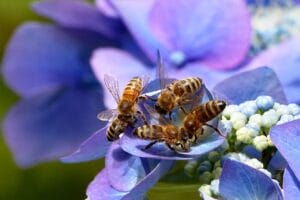
Environmentally friendly beekeeping means creating conditions that help bees thrive. This can include providing safe places for them to live, planting gardens that attract bees, and making sure they have water.
Making Habitats Safe
For bees to have safe habitats, they need certain resources. Here’s how you can provide them:
- Grow Local Flowers: Local plants are naturally suited to the area’s climate and provide the best nourishment for bees.
- Offer Nesting Spots: Different bees have different nesting habits. For instance, leave patches of exposed soil for bees that nest in the ground and offer wooden blocks with holes for mason bees.
- Steer Clear of Chemical Pesticides: Chemicals can be harmful to bees. Choose natural pest control methods instead.
Supplying Water Sources
Bees, like all living things, need water to live. Offering a water source in your garden or backyard can aid the local bee population. It’s an easy yet efficient way to aid in their survival.
When you’re establishing a water source, ensure that it’s not too deep and has lots of places for the bees to land. Bees can drown if the water is too deep, so it’s important to give them a safe place to drink. You could use a shallow dish with water and add some stones or sticks for the bees to land on.
Put the water source in a place that doesn’t get much sunlight to keep the water from getting too warm and evaporating. Make sure to keep an eye on it and refill it regularly so the bees always have fresh water to drink.
- Use a shallow dish or birdbath.
- Add pebbles or twigs for landing spots.
- Place the water source in a shaded area.
- Regularly check and refill the water.
Dealing with Bees
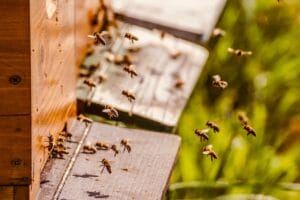
Stumbling upon bees in your garden or home can be nerve-wracking, but there are safe ways to deal with these situations. Understanding how to move bees and use natural repellents can help manage these situations without hurting the bees.
How to Safely Move Bees
When you stumble upon a bee hive or swarm in an unwanted place, the best course of action is to move them without harm. Begin by determining what kind of bees you’re dealing with. Honey bees, for instance, can usually be moved by a beekeeper in your area.
Reach out to a professional beekeeper or a pest control service in your area that focuses on bee removal. They possess the required tools and knowledge to move the bees without causing them any harm. You should not try to relocate the bees on your own because it can be risky and stressful for the bees.
Organic Bee Deterrents
There are times when you might need to discourage bees from visiting certain places, like decks or play areas. Organic bee deterrents can help you do this without hurting the bees.
There are some smells that bees can’t stand. These include cucumber skins, peppermint, and eucalyptus. If you want to keep bees away from a certain area, you could scatter cucumber skins around it or use essential oils like peppermint or eucalyptus to repel them naturally.
In addition, you can make a bee-deterrent spray by combining water with a small amount of peppermint or eucalyptus oil. Spray this blend around entrances, windows, and other places where you’d like to deter bees.
- Utilize cucumber peels as a natural deterrent.
- Spread peppermint or eucalyptus oil around the area.
- Formulate a bee-deterrent spray with water and essential oils.
How to Stay Calm Around Bees
Bees are usually non-aggressive and will not sting unless they feel endangered. Staying calm and avoiding abrupt movements can prevent bee stings. If a bee approaches you, remain motionless or move away slowly. Swatting at bees can agitate them and increase the chance of getting stung.
Steering Clear of Damaging Actions
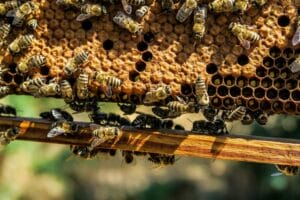
One must steer clear of actions that can damage bees, like utilizing pesticides. Pesticides have the potential to exterminate bees and interfere with their normal behavior, which can result in a decrease in bee numbers.
Rather than resorting to harmful chemicals, consider using natural options that are safe for bees and other helpful insects. Integrated Pest Management (IPM) is a sustainable approach that uses a combination of biological, cultural, and mechanical practices to control pests.
The Danger of Pesticides
Bees and other pollinators are at high risk from pesticides. The pesticides can pollute the nectar and pollen that bees gather and take back to their hives. This can result in colony collapse disorder, a condition where whole colonies of bees die.
Additionally, pesticides can hinder bees’ capacity to gather food, find their way, and reproduce. This not only influences bee populations but also the plants and crops that depend on bees for pollination.
“The use of pesticides can result in colony collapse disorder, which is when entire bee colonies die.”
Natural Solutions Instead of Chemicals
There are numerous natural alternatives to chemical pesticides that can assist in controlling pests without harming bees:
- Companion Planting: Certain plants, when planted together, can help keep pests away. For instance, aphids are repelled by marigolds, while mosquitoes are deterred by basil.
- Biological Control: You can introduce natural predators such as ladybugs and lacewings to keep pest populations under control.
- Mechanical Control: Physical barriers like row covers and traps can help protect your plants from pests.
Working with Local Beekeepers
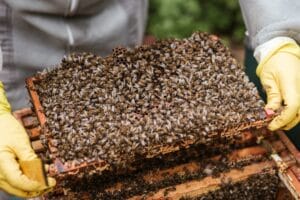
Working with local beekeepers can be a valuable source of support when it comes to managing bees. Beekeepers have the knowledge and experience to handle bees safely and effectively.
Locating and Reaching Out to Beekeepers
You can find a nearby beekeeper by looking through online directories, reaching out to local beekeeping groups, or getting suggestions from gardening clubs. Beekeepers are usually happy to assist with bee removal and relocation.
Advantages of Expert Bee Removal
There are several advantages to expert bee removal. Beekeepers employ gentle methods to move bees, guaranteeing their health and safety. They can also offer guidance on how to avoid future bee invasions and how to create a bee-friendly habitat.
Collaborating with beekeepers not only aids in the preservation of bees, but also bolsters the local beekeeping community.
Teaching Others About Bee Preservation
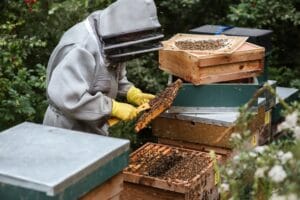
Teaching others about bee preservation is a key part of ensuring the survival of these important pollinators. By spreading the word, we can encourage more people to get involved and support bee-friendly practices. In this article, I’ll share some tips on how to educate your community about bee preservation.
Raising Awareness in Your Local Area
One of the best ways to raise awareness is by arranging community events. Organize workshops, seminars, or information sessions on the importance of bees and how to keep them safe. You could invite local beekeepers, environmentalists, and gardeners to share their expertise and experiences. For urban dwellers, understanding urban strategies for pest control can also be beneficial.
Furthermore, develop educational pamphlets and handouts to share at neighborhood farmers’ markets, plant nurseries, and community hubs. These resources should offer useful advice on establishing environments that are safe for bees, steering clear of damaging pesticides, and backing regional beekeepers.
Engaging Educational Institutions and Youth Organizations
Engaging educational institutions and youth organizations in the preservation of bees can have a significant influence. Collaborate with local schools to include bee preservation in their syllabus. You can propose to deliver lectures, arrange excursions to local bee farms, or supply educational resources.
Let’s get schools to start building pollinator gardens on their grounds. These gardens can be used as outdoor classrooms where students can learn about why bees and other pollinators are so important. Youth groups, like Scouts or 4-H clubs, can also get involved in saving the bees and earn badges or awards for their hard work.
Using Social Media to Promote Bee Conservation
Social media is an effective way to raise awareness about the importance of saving bees. You can create social media accounts that focus on promoting bee conservation and use them to share educational posts, videos, and infographics. You can also use these accounts to highlight local efforts to save bees, share stories of successful bee conservation efforts, and provide advice on what individuals can do to help protect bees.

Maximize your reach by using hashtags such as #SaveTheBees, #BeeConservation, and #PollinatorProtection. Encourage your followers to spread the word and engage in conversations about the importance of saving bees. By utilizing the reach of social media, you can encourage more people to take action and support practices that are beneficial to bees.
Commonly Asked Questions

Here are some questions that are often asked about bee management and conservation, along with helpful answers to address common worries.
What do I do if I find a beehive in my backyard?
If you discover a beehive in your backyard, the best thing to do is to reach out to a local beekeeper or a professional bee removal service. They can move the hive safely without hurting the bees. Don’t try to remove the hive on your own, it can be risky and cause stress to the bees.
Do any bee-attracting plants also deter other pests?
- Marigolds: Discourage aphids and mosquitoes.
- Lavender: Keeps moths, fleas, and flies away.
- Basil: Prevents mosquitoes and flies.
- Mint: Keeps ants and spiders away.
These plants not only encourage bees but also help control other pests.
How do I know if a swarm of bees is dangerous?
Generally, swarms of bees are not dangerous because they are usually just looking for a new home and are less likely to sting. However, if you live in an area with Africanized honey bees, also known as “killer bees,” you should be careful. These bees can be more aggressive and could be dangerous. If you’re not sure, get in touch with a local beekeeper or pest control expert to evaluate the situation.
What to do if a bee stings you?
Here’s what you should do if a bee stings you:
- Immediately scrape out the stinger with a fingernail or a credit card. Do not use tweezers as it can pump more venom into the skin.
- Rinse the area with soap and water.
- Put a cold pack on the area to reduce swelling and alleviate pain.
- If necessary, take an over-the-counter pain reliever like ibuprofen or acetaminophen.
- If you have severe allergic reactions such as difficulty breathing, swelling of the face or throat, or feeling dizzy, get medical help right away.
Why do bees prefer some areas more than others?
Bees are attracted to areas with lots of food sources, like gardens with blooming plants. They are also attracted to sources of water and protected nesting sites. Certain smells, like those from blooming flowers or specific plants, can also attract bees. By knowing what attracts bees, you can create environments that are good for their health and survival and manage their presence in areas where they might not be wanted.
Looking after bees without causing them harm involves a mix of understanding, hands-on tactics, and a dedication to preservation. By making environments that are friendly to bees, using repellents that are natural, working together with beekeepers in your local area, and teaching others about why bees are important, we can make sure that these crucial pollinators keep on thriving for many generations into the future.
The HTML you provided doesn’t contain any content to be rewritten. It’s just the basic structure of an HTML document with empty head and body tags.

